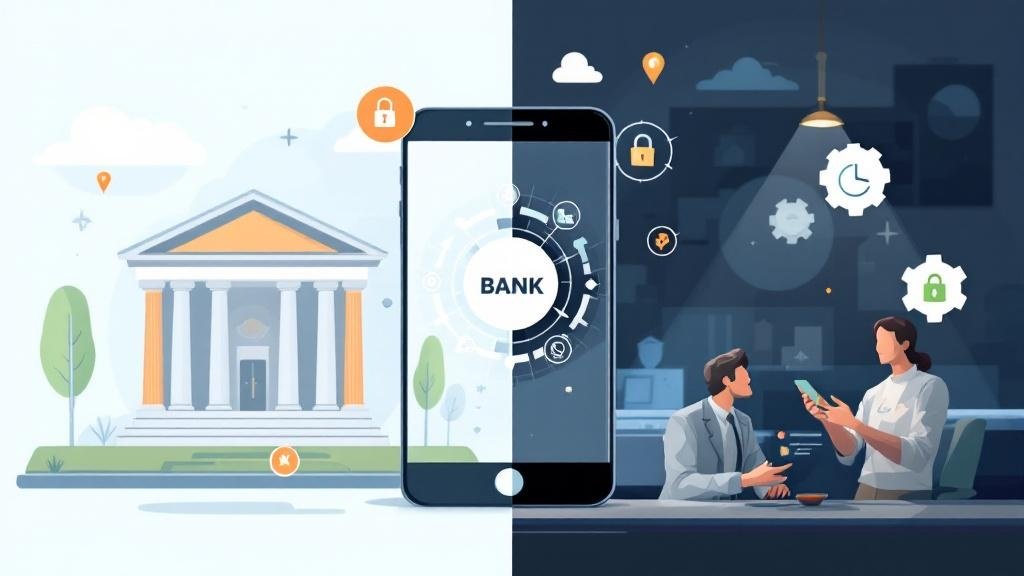In today’s fast-paced digital world, mobile banking has revolutionized how we manage our finances. But like any technology, there are occasional hiccups—like forgetting your password. If you’re finding yourself locked out of your mobile banking account, don’t panic. Whether you’re dealing with mobile banking for the first time or are an experienced user, regaining access is usually straightforward.
This guide will walk you through how to reset your mobile banking password and regain access quickly. We will also explore the growing importance of mobile banking vs traditional banking, the benefits of mobile banking, and the security features that help protect your account from fraud.
What is Mobile Banking vs Traditional Banking?
Mobile banking allows customers to access their financial services anytime and anywhere via a smartphone or tablet. This digital approach has become a game-changer, offering convenience and flexibility. In contrast, traditional banking refers to in-person services at physical branches, providing personalized customer service and the opportunity for face-to-face transactions. However, mobile banking’s convenience has made it the preferred choice for many users.
Mobile Banking Features
Mobile banking apps are designed to let you perform various tasks, including:
Checking account balances
Transferring funds between accounts
Paying bills
Applying for loans
Depositing checks remotely
These features make mobile banking an indispensable tool for managing finances on the go. As of today, the mobile banking vs traditional banking debate leans heavily toward the digital space, thanks to the speed and convenience mobile banking offers.
How to Reset Your Mobile Banking Password
It’s easy to forget your mobile banking password. Fortunately, most banks have an easy-to-follow process for resetting your password. Here’s a general step-by-step guide:
1. Open Your Mobile Banking App
Launch the mobile banking app on your phone. You’ll typically be prompted to enter your login details. If you’ve forgotten your password, tap on the “Forgot Password?” or “Reset Password” option.
2. Verify Your Identity
Banks require you to verify your identity for security reasons. This may involve:
Answering security questions
Receiving a One-Time Password (OTP) via SMS or email
Providing biometric verification (fingerprint or facial recognition)
3. Choose a New Password
Once your identity is verified, you can create a new password. Choose a strong, unique password that combines letters, numbers, and special characters. Avoid using easily guessable information like birthdays or names.
4. Confirm the Change
After entering and confirming your new password, you’ll receive a confirmation notification. Your account should now be accessible with your new credentials.
Mobile Banking Security: Keeping Your Account Safe
Mobile banking security is crucial to protecting your personal and financial information. Most mobile banking apps come with advanced security features, including:
Two-factor authentication (2FA): This adds an extra layer of protection by requiring a second form of identification.
End-to-end encryption: This ensures that your personal data is secure while it travels over the internet.
Biometric security: Many apps now offer fingerprint or facial recognition, making it harder for unauthorized users to access your account.
However, despite these features, it’s essential to stay vigilant. Here’s how to protect your mobile banking account:
Use strong, unique passwords: As we discussed earlier, using a unique and strong password is your first line of defense.
Enable two-factor authentication: If your bank offers 2FA, enable it for added security.
Avoid using public Wi-Fi: Avoid accessing your mobile banking app over unsecured Wi-Fi networks, as they can be a hotspot for hackers.
Mobile Banking Pros and Cons
While mobile banking offers numerous benefits, it’s not without its drawbacks. Let’s take a look at the pros and cons of mobile banking.
Pros of Mobile Banking:
Convenience: Access your bank account anytime, anywhere.
Faster Transactions: Transfer funds, pay bills, and make payments with a few taps.
Paperless Banking: Go green by opting for paperless banking statements.
Enhanced Security: Many mobile apps offer high-level encryption and multi-factor authentication.
Cons of Mobile Banking:
Dependency on Technology: Mobile banking relies on internet access and a functional device.
Limited Customer Service: While banking apps are user-friendly, they often lack the personalized service of in-branch visits.
Risk of Fraud: Despite security measures, mobile banking is still susceptible to phishing and other online fraud schemes.
Traditional Banking Advantages vs Digital Banking
While mobile banking vs traditional banking presents many advantages for the digital world, traditional banking still holds its ground in certain areas.
Advantages of Traditional Banking:
In-Person Customer Support: If you need to discuss complex financial issues, visiting a branch allows you to speak with a representative face-to-face.
Cash Handling: If you need to deposit cash or withdraw a large sum, physical branches are the way to go.
Personalized Service: Relationship banking still thrives in traditional banking, where you can work closely with your bank manager for personalized advice.
However, as digital banking services evolve, these traditional advantages are being addressed through things like video consultations and AI-powered support systems.
Banking Apps Comparison: Features and Benefits
Not all mobile banking apps are created equal. Different banks offer different features, so it’s important to choose one that fits your needs. Here’s a quick banking app comparison based on key features:
User Interface: A clean and intuitive user interface (UI) is essential for a smooth banking experience. Look for apps that are easy to navigate and user-friendly.
Security Measures: Banks with robust security measures like encryption, multi-factor authentication, and biometric login provide added peace of mind.
Mobile Transactions vs In-Person Transactions: Mobile banking apps allow you to do most tasks without needing to visit a branch. However, some tasks, like large withdrawals, may require an in-person visit.
Frequently Asked Questions (FAQs)
1. What’s the difference between mobile banking and online banking?
Mobile banking refers to managing your bank account through a mobile app on your phone or tablet, while online banking is typically accessed through a web browser on a desktop or laptop.
2. Is mobile banking safe from fraud?
Mobile banking is generally secure, with features like encryption, two-factor authentication, and biometric security. However, you should always be cautious of phishing scams and avoid using public Wi-Fi for banking.
3. Can I perform all banking tasks on mobile?
Yes, most mobile banking apps allow you to check balances, transfer funds, pay bills, and even deposit checks. However, for more complex services like applying for loans, you might need to visit a branch.
4. How can I secure my mobile banking account?
Use a strong password, enable two-factor authentication, and regularly monitor your account for unusual activity. Also, avoid accessing your account on public Wi-Fi networks.
5. What are the benefits of mobile banking?
The convenience of mobile banking allows you to access your account anytime and anywhere. You can make transactions quickly, track your spending, and reduce your paper usage with e-statements.








Comments (0)